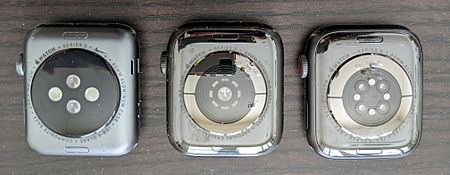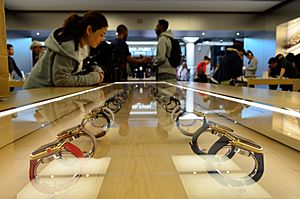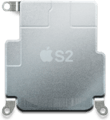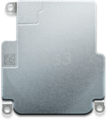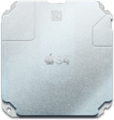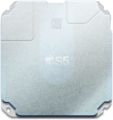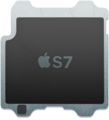Apple Watch facts for kids
 |
|
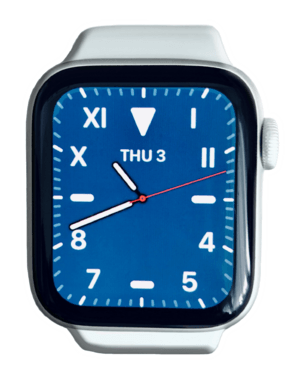
Fourth generation Apple Watch in 40 mm size
|
|
| Developer | Apple Inc. |
|---|---|
| Manufacturer | Quanta Computer |
| Type | Smartwatch |
| Release date | Early 2015 |
| Introductory price | From US$349 |
| Discontinued | September 7, 2016 (1st Generation) |
| Operating system | watchOS |
| CPU | Apple S1 |
| Display | Sapphire crystal, strengthened Ion-X glass |
| Connectivity | Bluetooth, NFC, Wi-Fi |
| Dimensions | Two case sizes: 38 mm and 42 mm |
| Website | https://www.apple.com/watch/ |
The Apple Watch is a popular smartwatch made by Apple Inc.. It's like a small computer on your wrist! It helps you track your fitness and health. It also lets you communicate wirelessly.
The Apple Watch works with your iPhone and other Apple devices. It first came out in April 2015. It quickly became the top-selling wearable device. By December 2020, over 100 million people were using an Apple Watch. Apple releases new versions, called 'Series', every September. Each new Series has better parts inside.
Apple Watch models come in different styles. You can choose different materials, colors, and sizes. Some models, like Series 1 and SE, are only made of aluminum. Starting with Series 3, some aluminum models can connect to LTE cellular networks. Other materials always include this feature.
You can pick from many bands when you buy an Apple Watch. There are also special versions. For example, Nike and Hermès team up with Apple. These versions have unique bands, colors, and watch faces.
The Apple Watch usually needs your iPhone to work fully. Your iPhone helps set it up and sync data. But the watch can connect to Wi-Fi on its own for some things. This includes basic messages and music streaming. Models with LTE can connect to a mobile network. This means you can make calls, send texts, and use apps without your iPhone nearby. Even with LTE, your iPhone still needs to be on and connected to a network for calls.
The newest Apple Watches come with watchOS 8. They need an iPhone 6S or newer with iOS 15 or later.
Contents
What is the Apple Watch?
The Apple Watch is a small computer you wear on your wrist. It helps you stay connected and healthy. It's designed to be easy to use.
Design and Materials
Every Apple Watch Series offers different styles. These styles depend on the case material, color, and size. Some special versions are made with Nike or Hermès. They come with unique bands and watch faces. Sometimes they even have special chargers or packaging.
When the Apple Watch first launched, there were three main types:
- Apple Watch Sport: This had an aluminum case.
- Apple Watch: This had a stainless steel case.
- Apple Watch Edition: This was originally made of 18-karat gold. Later models used different materials.
After Series 1 and 2, Apple stopped using the "Sport" name. Now, the Apple Watch comes with either an aluminum or stainless steel case. The "Apple Watch Edition" still exists. But now it means watches made from ceramic or titanium.
The first Apple Watch was not fully waterproof. It could handle splashes like rain or hand washing. But it was not meant for swimming. With Series 2, Apple made the watch much more water resistant. This meant you could swim and surf with it. The Series 7 also resists dust very well.
Sizes and Bands
The Apple Watch has always come in two sizes. These sizes mostly affect the screen size. At first, the sizes were 38 mm and 42 mm (height of the case). With Series 4, the sizes changed to 40 mm and 44 mm. For Series 7, they changed again to 41 mm and 45 mm.
The overall shape of the watch has not changed much. This means that bands and accessories usually fit any Apple Watch of the same size group. For example, bands for 38 mm, 40 mm, and 41 mm watches can be swapped. The same goes for 42 mm, 44 mm, and 45 mm watches. You can easily change the bands yourself. There's a special button on the watch to slide them out.
How You Control It and What It Senses
The Apple Watch has a "digital crown" on its side. This is a small dial you can turn to scroll or zoom on the screen. You can also press it to go back to the home screen. Next to the crown is the Side Button. This button shows your recent apps. It also lets you use Apple Pay for contactless payments.
The watch also has a touchscreen. Older models (before Series 6/SE) had "Force Touch." This meant the screen could tell the difference between a light tap and a harder press. This allowed for different menus. Force Touch was removed from Series 6 and SE. It was also turned off on older watches with watchOS 5.
The Apple Watch has many sensors. It has an accelerometer and gyroscope. These help it know how you are moving. It also has a barometer to measure altitude. All Apple Watches have a Heart Rate Monitor on the back. This uses lights to measure your heart rate. It shines green and infrared light onto your skin. Then it measures how much light bounces back. This helps it figure out your heart rate.
Starting with Series 4, Apple added electrical sensors. These let the watch take an electrocardiogram (ECG). This helps check your heart's electrical activity. The FDA approved this feature in 2018. The Series 6 (2020) added a blood oxygen monitor. This uses red lights to measure oxygen levels in your blood. It's for "wellness" and not for diagnosing medical problems. The Watch SE went back to the features of Series 3. It does not have the ECG or blood oxygen monitor.
Battery Life
Apple says the watch battery lasts about 18 hours with mixed use. You charge the Apple Watch using a special magnetic charger. If the battery gets very low (under 10%), the watch will tell you. You can then turn on "power reserve" mode. This lets you see the time for up to 72 more hours. Other features are turned off in this mode. The watch goes back to normal when it's charged or if you hold the side button.
Watch Bands
Your Apple Watch comes with a band to wear it on your wrist. You can easily change the band. Just hold down the small buttons on the back of the watch. Then slide the band pieces out. Many companies make bands for Apple Watch. Apple also makes many different bands in various materials and colors.
Older bands for 38 mm and 42 mm watches still fit newer models. For example, a 38 mm band fits 40 mm and 41 mm watches. A 42 mm band fits 44 mm and 45 mm watches.
Since Apple Watch Series 5, you can use the "Apple Watch Studio" online. This lets you pick any case and band combination you want. This makes it easier to get the exact style you like.
Apple Watch Models
As of September 2021, there have been eight generations and eight main "Series" of Apple Watch.
Apple Watch models are grouped into different "collections":
- Apple Watch: These usually have aluminum or stainless steel cases. They come with different bands.
- Apple Watch Sport: (First generation only) These had aluminum cases and sport bands.
- Apple Watch Nike+: (Series 2 and newer) These have aluminum cases and special Nike sport bands.
- Apple Watch Hermès: (First generation and newer) These use stainless steel cases and Hermès leather bands. They also include a special orange sport band.
- Apple Watch Edition: (First generation, Series 3, Series 5, Series 6 and newer) These originally used 18-karat gold. Later, they used ceramic or titanium cases.
Apple Watch Series 1 models were only available with aluminum cases and sport bands.
Starting with Series 3, aluminum models can be bought with or without LTE cellular connection. Models made of other materials (like stainless steel, ceramic, or titanium) always include LTE.
Each model up to Series 3 came in 38 mm or 42 mm sizes. The larger size had a slightly bigger screen and battery. Series 4 changed to 40 mm and 44 mm. Series 7 updated to 41 mm and 45 mm. Each model has many color and band choices. Apple makes bands like sport bands, sport loops, leather bands, and metal bracelets.
Images for kids
See also
 In Spanish: Apple Watch para niños
In Spanish: Apple Watch para niños



